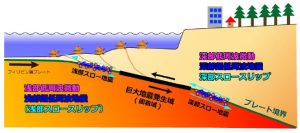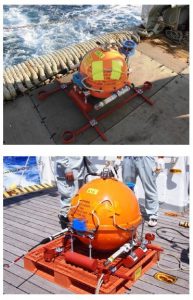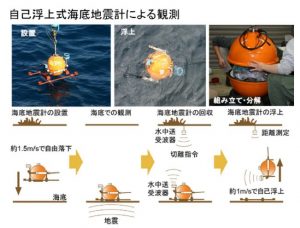Seafloor Observation Seismometer Installed in Hyuga-Nada
- Other
In March 2017, the research group of Assistant Professor Yamashita Hiroyo, Research Center for Earthquake Prediction, Disaster Prevention Research Institute (DPRI), Kyoto University, and Professor Shinohara Masayoshi Shinohara of the Earthquake Research Institute, The University of Tokyo et al. installed a seafloor observation seismometers in Hyuga-nada off Miyazaki Prefecture to conduct long-term ocean bottom earthquakes/geodetic observation.
The research group will investigate different characteristics of “slow earthquakes” occurring in the shallow plate boundary of the Hyuga-nada (near the trench axis), patterns and features in detail. The data will be used to ascertain the relationship between mega earthquakes along the Nankai Trough which usually trigger tsunamis, slow earthquakes that occur in the shallow parts of the plate, and other sophisticated research simulations.
Click here to view the full document in Japanese.

Observing position relationships of slow- and mega- earthquakes occurring in Southwest of Japan and the shallow and deep sides of mega-earthquakes occurring along the Nankai Trough.
Outline of the self-levitating ocean bottom seismometer. The data is taken out at the time of assembly / disassembly. Unlike cable type ocean bottom seismographs such as DONET and S – net, it is not possible to acquire real-time data. However, with its excellent mobility, it is possible to arrange multi-point dense observations.

A photograph of the ocean floor observation equipment. Above is a long-term observation type ocean bottom seismograph (sphere diameter 50 cm); and the picture below is a broadband ocean bottom seismograph (diameter of ball is 65 cm) with a pressure gauge sensor. The pressure gauge sensor was attached for long-term observations. When collecting, it separates the weight and levitates.






